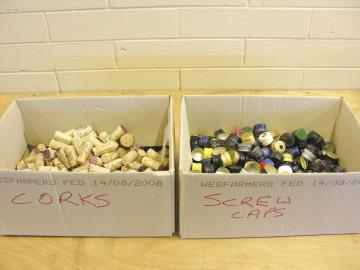Cork sniffing and Sangiovese
POSTED ON 31/05/2009Last week I spent mostly sniffing corks. Well, two actually. They were from Isole e Olena’s 2001 Cepparello and Costanti’s 2001 Brunello di Montalcino, both 100% sangiovese reds I’d bought and already enjoyed, so the anticipation was eager. There was no notable difference in the smell of the corks, but according to those who make a living out of serving wine, pulling the cork and sniffing it to make sure the wine isn’t corked, there should have been. Why? Because the Cepparello was horribly corked, while the Brunello was absolutely fine, better than fine in fact. The myth that by sniffing a cork you can tell if the wine’s corked or not is just that: a myth.
 To pull or to screw?
To pull or to screw?
This isn’t the place to go into the ins and outs, as it were, of the problem of cork taint. Suffice it to say that the problem of the corked bottle or TCA, the mouldy smell produced in some corks (5% seems to be the rough going rate) in the production process, is sufficiently endemic for the wine industry to have invested big time in alterative closures, the main ones being the screwcap, the synthetic cork and the vino-lok glass stopper.
I remember visiting Paolo de Marchi who makes Cepparello a few years back. We were standing on a stunningly beautiful Tuscan hill overlooking the tiny medieval village of Olena which forms part of his estate when a phone call came though from his British importer, David Gleave at Liberty Wines. Apparently he’d had a dinner the night before showcasing Isole e Olena and a couple of the wines had been corked. Paolo frowned. Thanks to the stupidity of the Italian wine laws, his chianti classico isn’t allowed to be sealed with anything other than cork because the DOCG rules forbid it. The Cepparello on the other hand, as an IGT supertuscan, could. It’s no coincidence that he’s now offering 2005 Cepparello under both cork and screwcap.
Paolo is a brilliant winemaker and his wines are always super-elegant, especially the Cepparello in a good vintage. He was in the forefront of the development of the supertuscan using only sangiovese for his wine rather than the more modish – at the time – blend of cabernet sauvignon or merlot created to give the wines greater international appeal (but cabernet often overpowers the more delicate sangiovese). His stance has been vindicated because while the Bordeaux blend can produce an excellent wine, viz. Fontodi’s Vigna del Sorbo, the pure sangiovese reds are by and large the truest and most typical expressions of the vineyard location, among them Fontodi’s Flaccianello, Felsina Berardenga’s Fontalloro and Paolo’s own Cepparello.
 Paolo and Marta ©italianfood.about.com
Paolo and Marta ©italianfood.about.com
Is there any difference between the 2005 under cork and that under screwcap? I thought you’d never ask. Yes, as it happens, there’s a big difference. The first is in the colour. The wine under screwcap is brighter and more youthful looking. More importantly, the nose of the screwcapped version is fresher, slightly greener and showing a touch of astringency and oak, but above all a lively freshness. The wine under cork is noticeably more evolved, showing a touch of savoury beefstock and Cherry Blossom (the boot polish, not the flower). On the palate, the wine under screwcap is distinctly fresher with brighter red cherry and plum fruits, that under cork a little duller but with slightly edgier, drier tannins and more obvious oak. The wine under screwcap is the Duracell vs. Brand X, the wine that will keep going longer by some distance.
Liberty Wines are offering them both at the same price to their customers, the Isole e Olena Cepparello 2005 under screwcap, £44.95 per bottle from Wimbledon Wine Cellar, that under cork from Majestic Wine (fine wine stores and online at majestic.co.uk), Noel Young Wines, Harrods, Green & Blue, Imbibros. Why so many wine merchants taking it under cork and not screwcap? Maybe they’ll let us know.
There are not many disappointments that rank with having bought an expensive bottle of a truly excellent wine, sat on it for a few years while it matures, and then opened it to find that it’s undrinkable because of the problem of cork taint. One of the most disappointing such occasions was when I took Marc Kent of Boekenhoutskloof out to dinner and raided the cellar to find a final bottle from the case of the 1990 Chave Hermitage to show the man whose 1997 Boekenhoutskloof Syrah was one of the first great South African syrahs. The Chave was corked.
Most great winemakers prefer screwcap to cork for obvious reasons but there are some, among them Paul Draper of Ridge and Paul Pontallier at Chateau Margaux, who say the jury is still out on red wines for long-term ageing. One of the best winemaking brains, Peter Gago of Penfolds, is talking about a new airtight glass disc he’s developing for Penfolds Grange. While he’s happy to use screwcap for anything that requires ageing for up to 30 years, his feeling is that those rare fine wines that need 30 years ageing plus, and Penfolds Grange, as numerous tastings have attested, is one of these, need a perfect seal. It’ll certainly save on all those Penfolds re-corking clinic bills.

